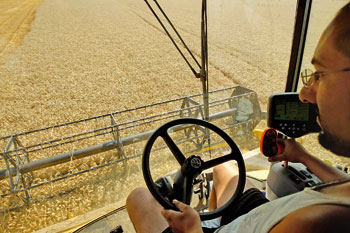 By Nikolay Golovanov
By Nikolay Golovanov
A tractor seeds a field with wheat, guided by a remote operator, who ‘drives’ from a comfortable cabin. He watches a display screen, making corrections where obstacles appear, turning the tractor as needed. The control panel shows the location of the tractor by GPS; the co-ordinate is updated twenty times per second, while a gyroscope and special sensors ensure all is accurate. The auto-pilot drives the tractor in a straight line, taking into account the width of the seeder.
The operator follows the process from his office, his computer recording all data: fuel consumption and the period of operation of all machinery in the field. Sometimes, weather conditions demand that fields be ploughed, seeded or harvested in short periods of time, necessitating 24 hour working days. The technology ensures that tractors can continue working safely even at night.
It might seem futuristic but automated machinery is growing in popularity. The technology is relatively new to Belarus though, explains Oleg Upenik, the chief agronomist at Belorussky Farm (in the Minsk region). “At our farm, we initially bought the necessary software,” he tells us. “After mastering it, we purchased mineral fertiliser spreaders and sprayers able to operate under the GPS system and an electronic map. Later, we bought tractors and seeders to work with this technology. It’s great when machinery operates automatically, without the need for a driver. A mechanical operator simply controls its work, while the machinery itself follows a set programme of spraying the necessary volume of fertilisers. It also works at a regular speed, ensuring consistency.”
According to Mr. Upenik, the novelty has improved labour efficiency. A man can seed only 35 hectares per shift, compared to the automated device covering 60 hectares. As a result, workers are less tired, operations are conducted efficiently and costs are falling.
Over the next five years, space technologies should become more common on farms, with applied space technologies, information and satellite navigation systems and other ‘sci-fi’ technology widespread by 2015.











